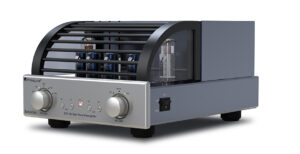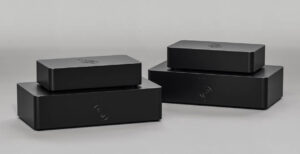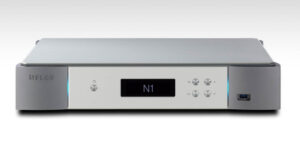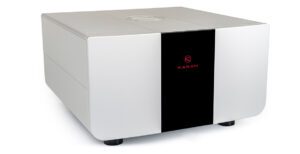
Audiovector has something of a gap problem. The Copenhagen-based brand has a couple of ranges of superb loudspeakers that cover the entry-level and attainably-priced regions of the audio market, it has the R11 flagship that costs an order of magnitude more than anything else the company makes, and then it has… nothing in between. Until now, as the R8 is perfectly designed to fill that gap.
However, filling in gaps in the portfolio is not Audiovector’s style; a good thing because too often those range-fillers in rival lines seem to be more about the ‘filler’ than adding something worthwhile to a loudspeaker line-up. As a result, the R8 pulls together the best of both Audiovector-shaped worlds; bringing much of the R11’s performance and technology to a wider audience both in terms of pricing and installation concerns, while distilling the best of what the more affordable SR-Series has to offer. In the process, the R8 allows Audiovector to take stock of developments in design and also becomes a platform to give us a taste of what might trickle down (and trickle up) into future designs.

The slim floorstanding design is very much Audiovector, so much so that the launch of the R8 at this year’s Munich High-End Show almost passed unnoticed. Unless you are an eagle-eyed follower of the brand, or see the models sitting side-by-side, you might be forgiven for mistaking the R8 as perhaps an SR6 Avantgarde Arreté in a rich and glossy burr walnut. Those eagle-eyed brand-followers would spot the extra bass unit and the increased height of the R8, but still might associate it with the SR6 line. This is quite remarkable because up close, you begin to realise just how physically imposing the R8 really is. It’s a tall, deep standmount that stands a smidgeon or two higher than a pair of Wilson Alexias, but because of the narrow front baffle and the boat-tailed rear, you simply don’t notice that size. It’s only when wheeling out the R8 and wheeling in the SR6 do you realise just how big they really are. The same holds to a lesser extent for the R11 flagship, but they stand noticeably tall. The R8’s advantage here is that you are not buying a visually arresting, room-dominating loudspeaker, unlike many of its up-scale contemporaries. OK, those who buy audio by the yard may want something more ostentatious to show off just how much they spent, but those of us who have shared listening rooms instead of dedicated man caves will relish the notion of outstanding sound without that constant ‘it’s too big and ugly’ complaint from your non-audiophile other half.
Audiovector isn’t a company that makes changes without good reason. It does have a consistent view of how to make a good sound and this is realised by its engineering. And like many companies, this corpus of engineering standards is improved upon with each successive product, adding its own innovations into the mix. The R8 is no different; it brings several important additions to the Audiovector canon.
For example, its new ‘Cross Woven Sandwich Carbon Driver’ was developed specifically for the R8 to improve upon the existing drivers found in the SR and R models: these have much lighter, stiffer, and more acoustically ‘dead’ membranes made from precision woven aramid fibres, sandwiched with artificial wood resin. Aramid is a term used in describing a range of extremely heat-resistant and exceptionally strong aromatic polymers. Audiovector claims this new membrane material produces faster, more uncoloured midrange and bass performance, and that certainly seems to be proved out in the listening.
Similarly, the company’s clever cabinet with an internal isobaric compound bass system uses hand-built 100mm rear-firing mid-bass drivers. This once again builds on the technology used in previous Audiovector designs (in this case the R11), but develops upon the previous model’s strengths. Also, the quasi-rear-firing Air Motion Transformer folded ribbon tweeter driver (Audiovector’s own, now in its third generation) is incorporated from the top Avantgarde Arreté models of the SR series and the R11. Internally, the R11 features cryogenically treated, ‘seven nines’ (99.99999% pure) copper wiring, in an asymmetrical loom and using the company’s own ‘Nanopore’ damping material, which is again developed from existing models, and is designed “to give a smooth and natural musical reproduction”.
The big development at present unique to the R8 is what Audiovector calls its ‘Freedom’ earth grounding system. This uses an extra terminal on the rear panel, designed to accept an earth cable, running to either an electrical or floating ground (such as Entreq). A notionally similar star-earthing arrangement was developed by Tannoy some years ago, but Audiovector’s Freedom system takes the concept and runs with it.
Freedom has the kind of across-the-range potential that companies like Audiovector crave. And, given the company’s strong adherence to an upgrade path in the SR series, don’t be surprised if an extra ‘speaker’ terminal begins to trickle down to more attainably-priced models in the portfolio. This might require a high degree of performance from the loudspeaker (I’m working with a sample of one here, and it’s a bit of a good one at that), but notionally this might be the kind of upgrade that only works with the biggest and best Audiovector has to offer. Or it might become a part of every product in the range. It’s certainly extremely audible, and that is easy to check – plug it into an earth, and the sound lifts further out of an already extremely quiet background. Unplug it and it drops back a couple of notches. And it does it instantly. I won’t say it’s audible to all or idiot-proof, because there are some remarkably resistant ears in audio, and nature has a way of constantly designing a better idiot, but if you can’t hear the difference between an earthed and unearthed speaker with the Freedom grounding system, you probably don’t need a loudspeaker as resolving as the R8. Or any of the SR range. Or a clock radio. Hell, if you can’t hear Freedom in action, stick with car alarms and klaxons. That’s about all your ears are good for… sorry!
As with the SR models, installation is fairly straightforward, and the usual ‘equilateral triangle, with a slight toe-in’ rules apply. But it’s here where Audiovector begins to show what it can be capable of. Just place them in the room as a ‘first fit’ as described and you’ll get good sound from them. Take time to install them with great care and attention, in particular making sure the distance from the side walls, rear wall, height and overall level are just right, and you go from ‘outstanding’ sound to ‘awesome’ sound! Of course, at this level, it’s likely you might not be the mover and installer of this loudspeaker, but make sure the person doing the installing knows what they are doing, all the same.
Also like existing Audiovectors, the R8 craves quality amplification. Not necessarily vast amounts of power, but something that combines power with some rhythmic ‘sass’. Audiovector was for the longest time Naim’s distributor in Denmark (perhaps understandably, that came to an end when Naim and Focal acted more in alignment across international distributors, and the electronics division in the hands of a rival to the loudspeaker division was never going to sit right) and that classic Naim sound blends perfectly with the R8. A NAP 300 power amp, for example, is ideal. More recently, Audiovector has been nuzzling up to fellow Danes Gryphon, and the Diablo 120 integrated from the brand makes for an awesome combination, especially when you mix in the Mohican CD player from fellow Scandiwegians, Hegel. But more on that later…
In a way, the review is easy. This does all the things the top of the SR range does, but more so and a lot, lot better. Most notable is the increased dynamic headroom. This will stump some of Audiovector’s detractors, who mistake control and grip for foreshortened dynamic range. The R8 proves them wrong in spectacular fashion, combining as it does edge-of-the-seat dynamics with the control and precision we have come to expect from the best Audiovectors.
This dynamic range comes across as a sense of unforced and effortless energy and scale to any recording. Play ‘Memphis Soul Stew’ [King Curtis Live at Fillmore West,ATCO] and when that brass section of the Memphis Horns kick in, instinct pushes you back in the seat. This track also highlights the freedom of the R8’s sound; Bernard Purdie’s powerful, rhythmically complicated yet deceptively simple shuffle pattern not only requires some muscle, but also needs a light touch to prevent it sounding like a distant and disorganised military band. On the R8, he’s in such good form, anyone with some drumming chops nearby will ‘just happen to pop round’ listen to him play those triplets against a half-time back-beat, look at their hands and feet, and start crying. It’s that effortless.

The R8 is also extremely detailed, and it’s here the Freedom earthing makes its mark. It ‘disappears’ the loudspeakers, leaving you with a soundfield of good, solid instruments in a physical space. It doesn’t sound like there are electronics, wood, and drive units in the way because that noise floor that you barely perceive, but underpins and undermines everything you hear drops further into the background. Vocal articulation, especially of solo female voices, is exceptional, even the syrupy close-miked Malia singing ‘Celestial Echo’ [Convergence, Universal] sounds less processed and more ‘in the room’.
I threw all kinds of music at the R8, from Richard Wagner to Kurt Wagner and back again, and nothing phased the R8. In comparison to the biggest of the SR series and the R11 context was quickly established. The R11 had more bass depth and ‘slam’, but the R8 had better finesse and control over that bass. Put another way, the R11 was the loudspeaker with the on-paper advantage of a few more bass pedal tones, but the R8 is the speaker you would happily prefer to live with. Meanwhile the SR series showed just how big a jump you make when going for the R8. It’s still a great – make that ‘outstanding’ loudspeaker system, but the R8 betters it in every respect. Tonally all three are close to one another, but the R8 just sings more in key.
Back to Hegel for the last blast. While the companies bigger amps would be a good match, the little Röst integrated amplifier couldn’t be a good match for the massive R8, could it? Actually, it worked extremely well. OK, so at anything beyond a reasonable early-evening chill-out volume level, the Röst began to run out of steam, hardening the top end and thinning down the bass slightly, and the overall package lost a lot of the finesse of the Gryphon-Audiovector combination, but the performance was still perfectly acceptable. OK, no-one is likely to plant a top-notch speaker with an amplifier this affordable, no matter how good the partnership, but it shows the R8’s ease of drive is not simply confined to the spec sheet. I’d still not use it with a low-power tube amp no matter how highly regarded, because I think the relative lack of damping factor valves bring may make those cones flap around too much, but in all other aspects of performance, the R8 is genuinely amp-agnostic.
I’m something of a fan of the Audiovector sound, as it combines the precision of something like a Dynaudio with the melodic sophistication of something like a Devore, or a Neat. But that combination gets taken to new levels in the R8, arguably more so than the R11. So often, flagship designs lose as much as they gain, and the best model (in musical terms) can be a more affordable model that was the original test-bed. ‘Less is more’ has resonance in high-end audio among those who let their ears decide their system choices, but the R8 takes that maxim on… and wins. This is the point of inflexion in the Audiovector range; yes the R11 is bigger sounding and in a very large room is generally a better performer, but the quality of the R8 makes it one hell of an upstart. I’d choose the R8 over the R11, and – perhaps more telling still – over the models in the SR range. It’s all pointing in the right direction!

TECHNICAL SPECIFICATIONS
Type: Four-way, rear-radiating floorstanding loudspeaker
Drive units: 1×Audivector-produced 3rd generation AMT folded ribbon tweeter with acoustic lens, 3× 152mm Audiovector titanium Aramid Sandwich mid-woofers
Frequency Response: 22Hz–52kHz (-6dB)
Sensitivity: 92.5dB
Nominal impedance: 8Ω
Crossover point: 100Hz, 250Hz, 3kHz
Reflex ports: 8” + 6” compound bass reflex
Star earth grounding: Audiovector Freedom Purifier
Dimensions (W×H×D): 22 × 145 ×47cm
Weight: 69.8kg
Price: £50,000 per pair
Manufactured by: Audiovector
URL: audiovector.com
Tel: +45 3539 6060
Tags: FEATURED
By Alan Sircom
More articles from this authorRead Next From Review
See all
PrimaLuna EVO 100 phono preamplifier
- Apr 22, 2024

Reiki Audio SuperSwitch Master Pro + Servant Pro
- Mar 27, 2024

Melco Audio N1-S38 music server
- Mar 27, 2024











